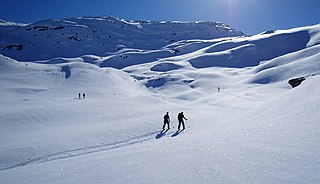
Cross-country skiing is a form of skiing whereby skiers traverse snow-covered terrain without use of ski lifts or other assistance. Cross-country skiing is widely practiced as a sport and recreational activity; however, some still use it as a means of transportation. Variants of cross-country skiing are adapted to a range of terrain which spans unimproved, sometimes mountainous terrain to groomed courses that are specifically designed for the sport.

Snowboarding is a recreational and competitive activity that involves descending a snow-covered surface while standing on a snowboard that is almost always attached to a rider's feet. It features in the Winter Olympic Games and Winter Paralympic Games.
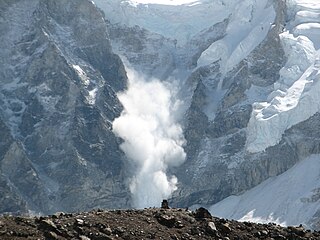
An avalanche is a rapid flow of snow down a slope, such as a hill or mountain.

A terrain park or snow park is an outdoor recreation area containing terrain that allows skiers, snowboarders and snowbikers to perform tricks. Terrain parks have their roots in skateparks and many of the features are common to both.
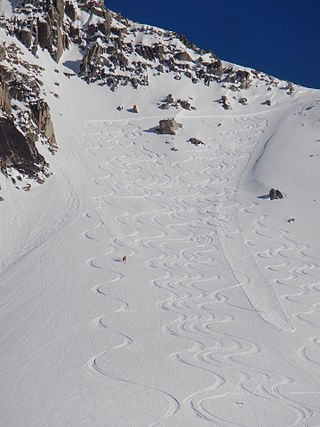
Backcountry skiing (US), also called off-piste (Europe), alpine touring, freeriding or out-of-area, is skiing in the backcountry on unmarked or unpatrolled areas either inside or outside a ski resort's boundaries. This contrasts with alpine skiing, which is typically done on groomed trails benefiting from a ski patrol. Unlike ski touring, backcountry skiing can - and often does - include the use of ski lifts including snowcats and helicopters. Recent improvements in equipment have increased the popularity of the sport. As the sport does confront the individual practicing it with the dangers of natural, unprepared alpine terrain like avalanches, it is generally recommended to carry standard safety equipment and to learn beforehand how to behave safely under such conditions.
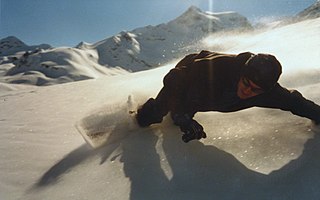
Freeriding is a style of snowboarding or skiing performed on natural, un-groomed terrain, without a set course, goals or rules. It evolved throughout the sport's formative early years as a contrary response to the highly regimented style of ski competition prevalent at the time. Snowboarders primarily refer to freeriding as backcountry, sidecountry, or off-piste snowboarding, and sometimes big mountain or extreme riding.

Galtür is a village and ski resort in the upper Paznaun valley in Austrian state of Tyrol located in the Central Eastern Alps 35 km southwest of Landeck near the border of Vorarlberg and Switzerland.

Big White Ski Resort, simply known as Big White, is a ski resort located 56 km (35 mi) southeast of Kelowna in the Southern Interior of British Columbia. It is located on Big White Mountain, the highest summit in the Okanagan Highland, an upland area between the Monashee Mountains and the Okanagan Valley. Big White is the fourth largest resort in British Columbia, after Whistler-Blackcomb, Sun Peaks, and Silver Star. In 2019, Big White was nominated as the third-best ski resort in Canada by Snowpak.

Heli-skiing is off-trail, downhill skiing or snowboarding where the skier reaches the top of the mountain by helicopter, instead of a ski lift.

The Stevens Pass Ski Area is a ski area in the Cascade Range of Washington in the United States. It is located at the crest of Stevens Pass at a base elevation of 4,061 feet (1,238 m) above sea level and peak elevation at 5,845 feet (1,782 m). The Mill Valley "backside" of the resort drops to a minimum elevation of 3,821 feet (1,165 m). Total skiable terrain includes 37 major runs covering 1,125 acres (4.55 km2). The ski area is accessed via U.S. Route 2, which connects to nearby Leavenworth.

Backcountry snowboarding is snowboarding in a sparsely inhabited rural region over ungroomed and unmarked slopes or pistes in the backcountry, frequently amongst trees, usually in pursuit of fresh fallen snow, known as powder. Often, the land and the snow pack are not monitored, patrolled, or maintained. Fixed mechanical means of ascent such as ski lifts are typically not present, but alternative means such as splitboarding, hiking, snowshoeing and helicopters ("heliskiing") are sometimes used to reach the mountain's peak.

Avalanche control or avalanche defense activities reduce the hazard avalanches pose to human life, activity, and property. Avalanche control begins with a risk assessment conducted by surveying for potential avalanche terrain by identifying geographic features such as vegetation patterns, drainages, and seasonal snow distribution that are indicative of avalanches. From the identified avalanche risks, the hazard is assessed by identifying threatened human geographic features such as roads, ski-hills, and buildings. Avalanche control programs address the avalanche hazard by formulating prevention and mitigation plans, which are then executed during the winter season. The prevention and mitigation plans combine extensive snow pack observation with three major groups of interventions: active, passive and social - sometimes more narrowly defined as "explosive", "structural", and "awareness" according to the most prevalent technique used in each. Avalanche control techniques either directly intervene in the evolution of the snow pack, or lessen the effect of an avalanche once it has occurred. For the event of human involvement, avalanche control organizations develop and train exhaustive response and recovery plans.
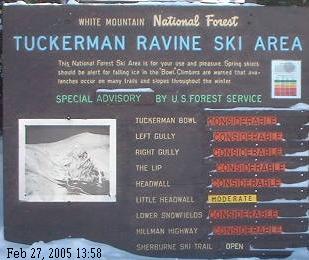
Avalanche rescue involves locating and retrieving people who have been buried in avalanches.
Temerity is a section of steep, gladed skiing terrain at Aspen Highlands, one of the four mountains owned and operated by the Aspen Skiing Company in Aspen, Colorado. "Boldness, to the point of being foolish," Temerity is designated as double-diamond experts-only terrain. Skiers and snowboarders should be practiced in tree skiing and aware of the dangers involved, and comfortable on experts-only mogul skiing runs such as Steeplechase before attempting.
Silverton Mountain is a ski area near Silverton, Colorado, United States that opened on January 19, 2002. Popular with skiers and snowboarders, Silverton Mountain has one chairlift that carries visitors into its terrain, which is for advanced and expert skiers or riders. Avalanche gear is required to ride the lift at all times due to the unpatrolled and ungroomed nature of Silverton. In addition to Silverton Mountain's 1,819 acres of lift accessed skiing, Silverton also serves as a base area for over 22,000 acres of helicopter accessed skiing. Uniquely, Silverton is only open Thursday through Sunday from December through April.
The 2012 Tunnel Creek avalanche occurred in the northwest United States on February 19, 2012. It happened at about noon PST in the Tunnel Creek section of Stevens Pass, a mountain pass through the Cascade Mountains of Washington, at the border of King and Chelan counties. There were three fatalities and one injured.

A cross-country skiing trail or loipe is a route that has been laid out, constructed and maintained specifically for cross-country skiing. Trails may extend point-to-point, but are more typically loops for recreational use or for competition. Until the mid-20th Century, trails were tracked by the passage of skiers. More recently, snow groomers set tracks for classic skiing and smooth lanes for skate skiing.

Beaver Valley Ski Club is a private skiing and snowboarding club located in Beaver Valley, Ontario, Canada.
This glossary of skiing and snowboarding terms is a list of definitions of terms and jargon used in skiing, snowboarding, and related winter sports.















